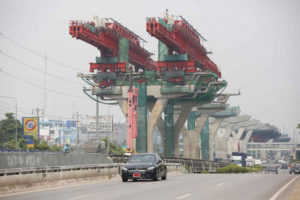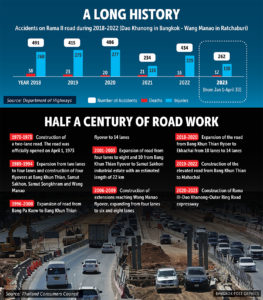
Roadworks on Bangkok’s Rama II Road to the south of Thailand still going after a dreary 50 years
Large construction projects, particularly those undertaken by the state, have significant impacts on communities and often the impacts are felt far beyond the construction sites.
One example is Rama II Road — which has been undergoing work for over five decades.
Safety concerns and poor traffic flow caused by work on the road — one of the primary routes to the southern region — are again in spotlight following a viral clip highlighting the construction saga.
Furthermore, a survey launched by the popular Facebook page “Paksabuy” last week, asked netizens to pick a reason behind the continuing decline in the number of tourists visiting Hua Hin.
While many netizens picked expensive accommodation and the nation’s poor economic recovery, congestion along Rama II Road topped the list of reasons for the town’s sagging popularity.
In response to complaints, Transport Minister Suriya Jungrungreangkit said the work is expected to finish in June 2025, an extension from the former deadline in January.
The delays are attributed to the contractor’s financial difficulties due to the Covid-19 pandemic and ministerial regulations restricting construction to night-time only so as to avoid traffic congestion.
The issue has also gained the attention of Prime Minister Srettha Thavisin who said efforts are being made to address the delays and that he would inspect the site soon.
He has also ordered the Transport Ministry to expedite work along Rama II Road.
The Bangkok Post talked to agencies involved in the work to find out why the project has been going on for more than 50 years without a clear end in sight.
Rama II Road, or Highway 35, falls under the jurisdiction of the Transport Ministry’s Department of Highways (DoH).
The 84km-route starts at Suksawat Road in Bangkok, passes through Samut Sakhon and Samut Songkhram and intersects with Highway 4 (Phetkasem Road) at Ban Wang Manao in Ratchaburi’s Pak Tho district.
Construction of the road, initially planned as a two-lane road, began in 1970 and finished in 1973 under a budget of 359 million baht. The road shortens the distance from Bangkok to the southern region by about 40km, compared to Phetkasem Road.
Since its construction began, there has always been some sort of work in progress due to the increased volume of traffic. The road has been gradually expanded over the years and currently there are 10 lanes available for traffic.
According to a source in the Transport Ministry, about 70 projects including repair and expansion work were undertaken from 1970–2017, with estimated costs of 17 billion baht.
Currently, four projects are under way on Rama II Road and they are slated to be completed in 2024–2025.
They are the 18.7km Rama III-Dao Khanong project at a cost of 30 billion baht by Expressway Authority of Thailand (Exat); the 8.3km elevated road from Bang Khun Thian to Ekkachai at a cost of 10 billion baht; the 16.3km road from Ekkachai to Ban Phaeo at a cost of 18.7 billion baht; and the elevated road project at Ban Phaeo at a cost of 600 million baht.
The costs of projects taken on Rama II since 1970 are estimated at 77 billion baht, according to the source.
Rama II Road has heavy traffic, between 200,000 and 250,000 vehicles per day, and traffic usually increases 1.5 times during long holidays such as Songkran and New Year festivities.
“Motorists travelling south don’t have many choices because other routes take longer to reach their destinations. Those heading north and northeast have more route choices, and the differences in distance aren’t significant,” said the source.
Previous governments had allocated more funds to expand roads leading to other regions rather than to the south, and in recent years funds were allocated for the development of rail transport throughout the country.
A host of problems
DoH director-general Sarawut Songsivilai said the high volume of traffic on Rama II Road poses obstacles to traffic management during construction work resulting in congestion.
 To enhance safety and reduce impacts on traffic flow, work on Rama II is moving at a slower pace, he said, noting that as part of the double safety policy, contractors can carry out work from 9pm–5am only.
To enhance safety and reduce impacts on traffic flow, work on Rama II is moving at a slower pace, he said, noting that as part of the double safety policy, contractors can carry out work from 9pm–5am only.
According to the Exat, the agency is speeding up work on the eight-lane bridge built parallel to Rama IX Bridge so it can open to traffic in July this year to facilitate traffic to Rama II Road.
The mainline, which runs from the beginning of Rama II Road to Bang Khun Thian, is expected to be completed in June next year to allow for a smooth journey to the DoH’s elevated road along Rama II Road.
Former deputy Bangkok governor Samart Ratchapolsitte said in a social media post that prolonged construction has not only affected communities but also commuters, with traffic congestion and fatal accidents putting off many motorists.
He compared construction of Rama II Road with Bang Na-Trat Road which is one of the routes to the eastern region. Despite having similar soil types, project designs, and agencies involved in the construction, Bang Na-Trat Road did not take as long to complete as Rama II Road.
According to Mr Samart, Bang Na-Trat Road, formally known as Theparat Road, was built in 1967 and completed in 1969. Initially as a two-lane road, it was later widened without causing much inconvenience to the public.
He said work delays on Rama II could be attributed to almost simultaneous implementation of the expressway and the elevated road.
Assoc Prof Sutthisak Sornlum, a lecturer at Kasetsart University’s engineering faculty, said work on Rama II Road is tough because of the type of soil in the area. This soil might lead to the road sinking after it is finished.
Voices of those hit by delays
People have raised their concerns about the effects of the work along Rama II Road.
Several accidents and deaths have been reported in recent years.
Janwit Kiamsawad, 50, a driver who has been working for more than 15 years, shared his views on how the work has affected his life. “It seems this work is never-ending. It causes traffic jams and cuts road lanes. And it affects the whole economy. I have to reduce trips because of the traffic.
“A recent problem is wastewater on the road. About 8–9pm some days, they drill a water hole and then pour wastewater on the road. It causes accidents, especially for motorcycles. It is a dark and slippery road,” he said
A 46-year-old merchant near Rama II Road for six years, who asked not to be named, said she was concerned the dust and scrap from the construction work may cause accidents for residents. “I heard yesterday about some metal which fell from the construction site. Thankfully, no one was hurt, but they really should try to finish as soon as they can.”
Another driver in his 30s also highlighted the wastewater problem and the scrap metal from the site. “I’ve seen bits of metal drop many times. As you can see in the news, it has caused deaths. When it rains, they drill into the wastewater and pour it on the road. There are many accidents, and motorcyclists come to grief because of the slippery conditions.
“Actually, they have a wastewater suction truck. But they do not use it, they just pour it on the road and it causes accidents,” he said.
A group of taxi drivers has been affected by the work as they have been working around Rama II Road.
“It is so uncomfortable and causes a lot of problems such as traffic jams, dust, loud noise, and wastewater. Recently, we have also found mud left on the road.
“And the workers do not clear after themselves properly. I have been seeing this problem for a while. The longer it takes, the more problems occur. I want them to finish as soon as possible, and give us back the road lanes so life can go back to normal with less traffic,” the driver said.
Source: https://www.bangkokpost.com/thailand/special-reports/2751946


